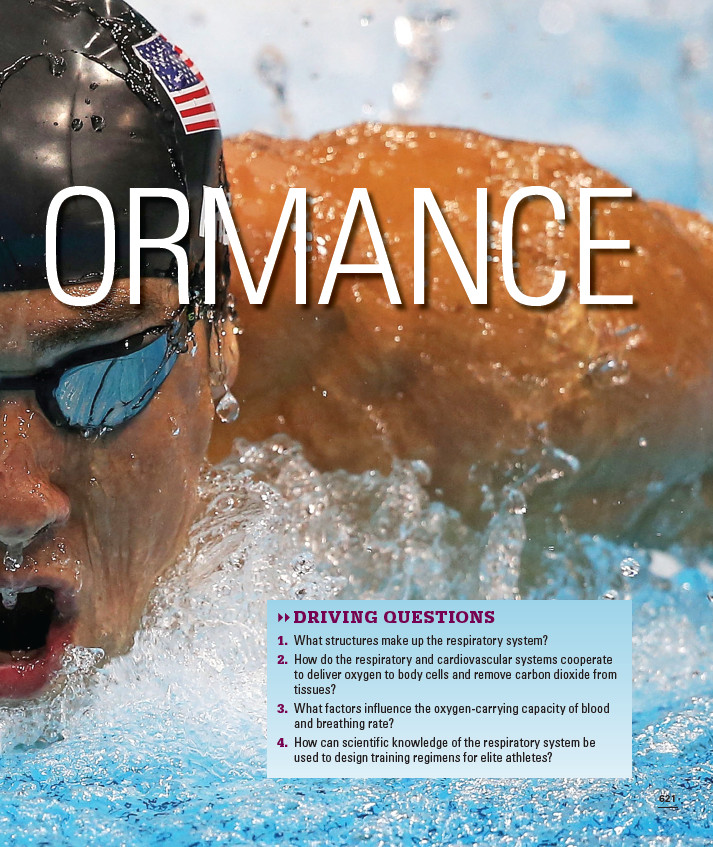


 DRIVING QUESTIONS
DRIVING QUESTIONS
- What structures make up the respiratory system?
- How do the respiratory and cardiovascular systems cooperate to deliver oxygen to body cells and remove carbon dioxide from tissues?
- What factors influence the oxygen-carrying capacity of blood and breathing rate?
- How can scientific knowledge of the respiratory system be used to design training regimens for elite athletes?
In-Class Activity
Click here to access Lecture ppt specifically designed for chapter 28.
Click here to access Clicker Questions specifically designed for chapter 28.
 ITH A WINGSPAN OF 6 FEET 7 INCHES, FEET THE SIZE OF FLIPPERS, and just 4% body fat, swimmer Michael Phelps is built for speed. He holds seven current world record titles, is an 18-time Olympic gold medalist, and is universally recognized as the greatest swimmer of all time. With stats like these, it’s hard to imagine how he could possibly improve his performance—short of growing gills. Yet the 27-year-old athlete proved he still has a few tricks up his swimsuit when he announced in June 2012 that he sleeps in a “contraption” designed to give him an athletic boost.
ITH A WINGSPAN OF 6 FEET 7 INCHES, FEET THE SIZE OF FLIPPERS, and just 4% body fat, swimmer Michael Phelps is built for speed. He holds seven current world record titles, is an 18-time Olympic gold medalist, and is universally recognized as the greatest swimmer of all time. With stats like these, it’s hard to imagine how he could possibly improve his performance—short of growing gills. Yet the 27-year-old athlete proved he still has a few tricks up his swimsuit when he announced in June 2012 that he sleeps in a “contraption” designed to give him an athletic boost.
“When I walk into my bedroom, I still have to open another door to get to my bed,” explained the swimmer to Anderson Cooper on 60 Minutes. “It’s kind of a boy in bubble sort of thing.”
Phelps wouldn’t show the device on TV, but he later tweeted a picture of the glasswalled structure to his followers. Known as a hypoxic chamber, the device creates an artificial low-oxygen environment, equivalent to that at 8,000 feet above sea level. The swimmer claims that sleeping in the chamber every night while he’s training helps his body heal faster. In fact, it was a central part of his training regimen as he prepared for the summer 2012 Olympics in London, at which he broke the world record for most medals won by an Olympian—22 in all.

Phelps isn’t the only elite athlete to resort to a technical fix for improved performance. Manufacturers of hypoxic chambers have seen an increased interest in their product from athletes such as tennis pro Novak Djokovic and triathlete Jonathan Brownlee. Even entire Olympic sports teams are getting in on the action.
But what does sleeping in a low-oxygen chamber have to do with athletic performance? Does it work? And is it ethical?
According to Randall Wilber, a sports physiologist with the U.S. Olympic Training Center in Colorado Springs, Colorado, the use of hypoxic chambers is a variation on the theme of natural altitude training. Athletes spend several weeks living at high altitude, typically defined as 6,000 feet or more above sea level, and then return to sea level to train or compete. The widely used practice is based on the idea that the body will acclimatize to higher elevation by becoming better able to take up and transport oxygen, ultimately improving performance.
“If you look at the number of athletes who win medals in winter sport, summer sport, across many endurance-based sports, I would say in my estimation 90–95% of those athletes at minimum are using altitude training in some way or another,” says Wilber.
But with more and more athletes using technical means to enhance performance, many in the sports field are taking a closer look at the practice, and some are asking questions about fairness.